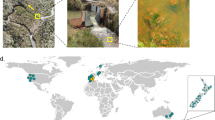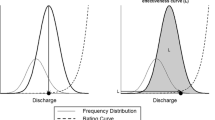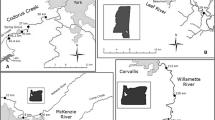Abstract
In running waters, the concentration of components that define water quality can be subjected to ample fluctuations quantitatively linked to flow rate. If not properly considered, such variability may hinder assessment of the evolution of water quality, of the effects of management actions, and ultimately the understanding of processes driving water quality. The functional response to flow rate was characterized for multiple biogeochemical variables in a pristine, low order stream. Variability of responses spanned between a factor of 2 and > 34, and in all cases were associated to flow rate according to one of three patterns: positive asymptotic (for variables: seston, suspended particles, total nutrients, dissolved and particulated organic matter, dissolved inorganic nitrogen), negative asymptotic (conductivity and dissolved reactive silicon), and humped (dissolved inorganic phosphorous). Building on those results, a rationale is presented for an unambiguous, cost-effective approach to water quality evaluation in running systems with predominantly diffuse sources.






Similar content being viewed by others
Availability of data and material
The datasets generated and/or analyzed during the current study are available from the corresponding author on reasonable request.
Code availability
Data analyses and representation were performed under the free, open code software R, and libraries cited in “Methods.”
References
Achkar, M., Díaz, I, Dominguez, A., & Pesce, F. (2016). Uruguay: naturaleza, sociedad, economía. Banda Oriental, Montevideo. 374p.
APHA. (2017). Standard methods for the examination of water and wastewater, 23rd edition. RB Baird, AD Eaton, EW Rice (editors). American Public Health Association, Washington, USA. 1546 p.
Baker, D. B., Richards, R. P., Loftus, T. T., & Kramer, J. W. (2004). A new flashiness index: Characteristics and applications to midwestern rivers and streams. Journal of the American Water Resources Association, 40, 503–522. https://doi.org/10.1111/j.1752-1688.2004.tb01046.x
Breitburg, D., Levin, L. A., Oschlies, A., Grégoire, M., Chavez, F. P., Conley, D. J., Garçon, V., Gilbert, D., Gutiérrez, D., et al. (2018). Declining oxygen in the global ocean and coastal waters. Science. https://doi.org/10.1126/science.aam7240
Brooks, K. N., Ffolliott, P. F., & Magner, J. A. (2013). Hydrology and the management of watersheds. Wiley-Blackwell, Oxford UK. 533 p.
Burnham, K. P., & Anderson, D. R. (2002). Model selection and multimodel inference: A practical information- theoretic approach. Springer.
Cassidy, R., & Jordan, P. (2011). Limitations of instantaneous water quality sampling in surface-water catchments: Comparison with near-continuous phosphorus time-series data. Journal of Hydrology, 405, 182–193. https://doi.org/10.1016/j.jhydrol.2011.05.020
CRAN. (2020). Segmented: Regression models with break-points / change-points estimation. Electronic document available at: https://cran.r-project.org/web/packages/segmented/index.html . Last visited 20 october 2020.
Crawley, M. J. (2013). The R Book (2nd ed., p. 975). John Wiley & Sons.
Decree 253/79uy. Prevention of environmental contamination through control of water (original in Spanish). [online] https://www.dinama.gub.uy/rlau/index.php?option=com_docman&view=document&slug=decreto-25379&layout=default&alias=32-decreto-25379&category_slug=nacional&Itemid=124 . [Accessed 20 October 2020).
Diaz, R. J., & Rosenberg, R. (2008). Spreading dead zones and consequences for marine ecosystems. Science, 321, 926–929. https://doi.org/10.1126/science.1156401
Duarte, C. M., & Regaudie-de-Gioux, A. (2009). Thresholds of gross primary production for the metabolic balance of marine planktonic communities. Limnology & Oceanography, 54, 1015–1022.
EPA. (2014). Water Quality Standards Handbook. Chapter 1: General Provisions. Office of Water EPA 820-B-14–008, 10 p.
EPA. (2000). Nutrient criteria technical guidance manual rivers and streams. EPA-822-B-00–002. Office of Science and Technology, Washington, 250p.
EPA. (2020). Water Quality Standards Handbook. [online] Available at: https://www.ecfr.gov/cgi-bin/text-idx?SID=7977290449ab243f2865159951305a77&node=40:22.0.1.1.18&rgn=div5#sp40.24.131.d [Accessed on 19th October 2020].
Esteves, F. A. (1998). Fundamentos de Limnologia. 2nd Edition, Interciencia, Rio de Janeiro, 602 p. (In Portuguese).
EU. (2010). Water framework directive. [online] Available at: http://jncc.defra.gov.uk/page-1375 [Accessed 20 October 2020].
Goyenola, G., Meerhoff, M., Teixeira-de Mello, F., Bergonzoni, I., Graeber, D., Fosalba, C., Vidal, N., Mazzeo, N., Ovesen, N. B., Jeppesen, E., & Kronvang, B. (2015). Monitoring strategies of stream phosphorus under contrasting climate-driven flow regimes. Hydrology and Earth Systems Science, 19, 4099–4111. https://doi.org/10.5194/hess-19-4099-2015
Inumet (National Institute of Meteorolgy). (2020). [online] https://www.inumet.gub.uy/clima/climatologia-estacional (in Spanish). [Accessed 20 October 2020].
Kauppila, P., & Koskiaho, J. (2003). Evaluation of annual loads of nutrients and suspended solids in Baltic rivers. Nordic Hydrology, 34, 203–220.
Lewis, W. M. (2008). Physical and chemical features of tropical flowing waters. Dudgeon (pp. 1–21). D. Tropical stream ecology. Academic Press.
Mann, K. H., & Lazier, J. R. N. (2006). Dynamics of marine ecosystems: Biological-physical interactions in the oceans. 3rd edition Blackwell Publishing Massachusetts. 520 p. ISBN-13: 978–1–4051–1118–8.
MGAP (Ministerio de Ganadería, Agricultura y Pesca - Uruguay). (2018). Land cover/ use in Uruguay year 2018 [online]. http://web.renare.gub.uy/SIG/Cobertura/Raster_Cob_Uso_Uruguay2018.zip
Muggeo, V. M. R. (2008). Segmented: An R package to fit regression models with broken-line relationships. R News 8: 20–25. ISSN 1609–3631.
Muñoz, J., Ross, P., & Cracco, P. (2007). Flora indígena del Uruguay: Árboles y arbustos ornamentales. Editorial Hemisferio Sur. 320 pp.
MVOTMA. (2017). National Water Plan (original in Spanish). [online] https://www.gub.uy/ministerio-ambiente/sites/ministerio-ambiente/files/2020-07/Plan-Nacional-de-Aguas.pdf
Pote, D. H., Daniel, T. C., Sharpley, N. A., Moore, P. A., Edwards, D. R., & Nichols, D. J. (1996). Relating extractable soil phosphorous to phosphorous losses in runoff. Soil Science Society of America Journal, 60, 855–859.
R core team., (2020). R: A language and environment for statistical computing. R Foundation for Statistical Computing. Vienna, Austria, https://www.R-project.org. Accessed October 20 2020.
Roberts, W. M., Stutter, M. I., & Haygarth, P. M. (2012). phosphorus retention and remobilization in vegetated buff er strips: A review. Journal of Environmental Quality., 41, 389–399. https://doi.org/10.2134/jeq2010.0543
Rozemeijer, J., Dervelde, Y., Vangeer, F., de Rooij, G. H., Tores, P., & Broers, H. P. (2010). Improving load estimates for NO3 and P in surface waters by characterizing the concentration response to rainfall events. Environmental Science and Technology, 44, 6305–6312.
Stenback, G. A., Crumpton, W. G., Schilling, K. E., & Helmers, M. J. (2011). Rating curve estimation of nutrient loads in Iowa rivers. Journal of Hydrology, 396, 158–169. https://doi.org/10.1016/j.jhydrol.2010.11.006
Smith, L., Porter, K., Hiscock, K., Porter, M. J., & Benson, D. (2015a). Catchment and river basin management (p. 292). Routledge Publisher New York.
Smith, L., Hiscock, K., Porter, M. J., Krueger, T., & Benson, D. (2015b). Getting informed: tools and approaches for assessment, planning and management. In: Smith, L., Porter, K., Hiscock, K., Porter, M. J., Benson, D. (editors) Catchment and river basin management. Integrating Science and Management. Routledge Publisher New York. 222.238.
Spiess, A. N. (2018). Package propagate: Propagation of uncertainty. CRAN repository. https://CRAN.R-project.org/package=propagate
van Geer, F. C., Kronvang, B., & Broers, H. P. (2016). High-resolution monitoring of nutrients in groundwater and surface waterSs: Process understanding, quantification of loads and concentrations, and management applications. Hydrology and Earth Systems Science, 20, 3619–3629. https://doi.org/10.5194/hess-20-3619-201
Young, E. O., & Briggs, R. D. (2008). Phosphorus concentrations in soil and subsurface water: A field study among cropland and riparian buffers. Journal of Environmental Quality., 37, 69–78. https://doi.org/10.2134/jeq2006.0422
Acknowledgements
The present investigation was funded by the Comisión Sectorial de Investigación Científica, Universidad de la República (Uruguay) through DT grants to Danilo Calliari and Laura Rodríguez-Graña. The contribution of Mona Calliari to the conception of the study and during field work is deeply appreciated. Comments and constructive criticism by anonymous reviewers contributed to improve this paper.
Funding
Research was funded by the Comisión Sectorial de Investigación Científica, Universidad de la República, Uruguay, through DT grants to Danilo Calliari and Laura Rodríguez-Graña.
Author information
Authors and Affiliations
Contributions
All authors contributed to the study conception, design, data collection and analysis. The first draft of the manuscript was written by DC and all authors commented on successive versions. All authors read and approved the final manuscript.
Corresponding author
Ethics declarations
Conflict of interest
The authors declare no competing interests.
Additional information
Publisher's Note
Springer Nature remains neutral with regard to jurisdictional claims in published maps and institutional affiliations.
Rights and permissions
About this article
Cite this article
Calliari, D., Lescano, C. & Rodríguez-Graña, L. Biogeochemical functional responses to flow rate in a low order stream: implications for water quality monitoring. Environ Monit Assess 194, 634 (2022). https://doi.org/10.1007/s10661-022-10242-1
Received:
Accepted:
Published:
DOI: https://doi.org/10.1007/s10661-022-10242-1




